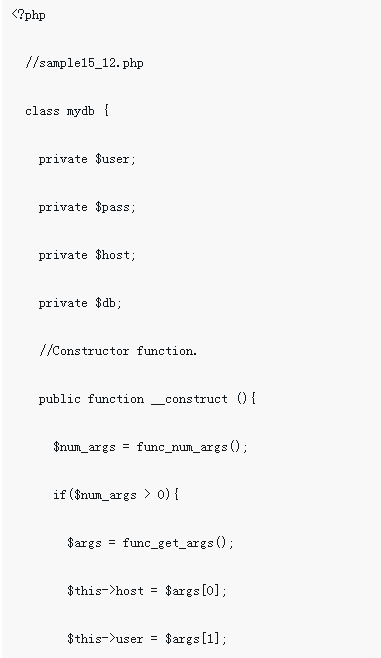<?php
namespace JasonGrimes;
class Paginator
{
const NUM_PLACEHOLDER = '(:num)';
protected $totalItems;
protected $numPages;
protected $itemsPerPage;
protected $currentPage;
protected $urlPattern;
protected $maxPagesToShow = 10;
protected $previousText = 'Previous';
protected $nextText = 'Next';
/**
* @param int $totalItems The total number of items.
* @param int $itemsPerPage The number of items per page.
* @param int $currentPage The current page number.
* @param string $urlPattern A URL for each page, with (:num) as a placeholder for the page number. Ex. '/foo/page/(:num)'
*/
public function __construct($totalItems, $itemsPerPage, $currentPage, $urlPattern = '')
{
$this->totalItems = $totalItems;
$this->itemsPerPage = $itemsPerPage;
$this->currentPage = $currentPage;
$this->urlPattern = $urlPattern;
$this->updateNumPages();
}Pagination is to divide a page into two or more pages.
There is an automatic paging mechanism that can divide the content in the mobile Web form into a group of smaller pages for presentation to suit the specific device. This mechanism also renders user interface elements that can be used to navigate to other pages. No matter how much memory your NT server has, it's always not enough. When physical RAM is running low, Windows NT uses the paging file Pagefile.sys. In order to run different processes and applications, Pagefile.sys allocates some space to the physical memory. Swapping of data pages is allowed within these spaces. Apparently, the performance of the system will be improved by having the system look for data in the file system cache rather than searching for the data on the drive. Too many search operations can bog down the processor. This is one reason the phrase "buy more memory" has become a cliche of the computer age: RAM is your friend. Managing memory makes your "friends" more efficient.
Windows Task Manager ([Ctrl][Alt][Delete] | Task Manager) under Windows NT is a viewing tool that can provide quick and important information for accessing memory usage. Memory Usage History provides an immediate picture of memory activity by taking into account the size of physical memory and calculating the value of the MEM Usage counter. Comparing the CPU Usage counters and CPU Usage History with the MEM Usage counters provides a simple overall performance evaluation. This is very convenient if you have to decide whether to launch Diskperf immediately to further investigate an excessive paging problem. The Windows NT paging file can be managed through Control Panel | System | Performance tab | Virtual Memory. Here, you can control several settings for the paging file (including size and area). Obviously, you can allow the system to handle it, but for optimal configuration it's better to use the Visual Memory Manager (VMM).
Basic Principles of Windows NT Paging File Windows NT initially sets the starting paging file size by adding 12MB to the amount of physical RAM. This 12MB allows for the paging file contents to be dumped into a log as a precaution in the event of a system failure. If you see a Stop box followed by a blue screen of death, you've encountered this problem in your operation. If the size of the starting paging file is less than this number (the amount of physical RAM plus 12MB), you will start to receive Running Out Of Memory messages. The Windows NT operating system and its applications use approximately 10MB of RAM. Therefore, this value should be subtracted from the amount of physical RAM. This will give you plenty of wiggle room in determining your server's memory requirements. Windows NT requires a minimum paging file size of 2MB. If the paging file is too small or does not exist at all, a warning message will appear at startup.
The rule of minimum RAM of 12 should always be followed. Under no circumstances can the paging file be smaller than the size of the RAM in the server. If the system has 32 MB of physical RAM, plus 12 MB, the total size of the paging file is 44 MB. Obviously, the larger the paging file, the better. Meaning increasing the investment in physical RAM rather than simply increasing the size of the paging file. Without enough RAM, the drive will spend too much time reading and writing to the paging file. This will only slow down the server, or even render it inoperable if the server has to be restarted to clear I/O requests. And if the machine needs to be restarted for this reason, there may be a second time. The default 12MB of RAM is sufficient to clear the contents of the paging file when necessary. Small paging files limit what can be stored and may exhaust the virtual memory reserved for applications. If there is not enough RAM, there will be more paging, which in turn puts extra burden on the drive, making the system less responsive. In this case, Windows NT requires that the minimum size of the paging file be equal to the size of the physical RAM in addition to the 1MB of virtual memory at system startup in order to be able to write debugging information to a file. As mentioned earlier, the maximum and minimum size of the paging file are specified in the Virtual Memory dialog box. Depending on the application, the paging file grows and shrinks. The paging file cannot be compressed or maintained while the system is running. However, paging files can be maintained using various third-party software packages such as Diskeeper.
All resources on this site are contributed by netizens or reprinted by major download sites. Please check the integrity of the software yourself! All resources on this site are for learning reference only. Please do not use them for commercial purposes. Otherwise, you will be responsible for all consequences! If there is any infringement, please contact us to delete it. Contact information: admin@php.cn
Related Article
 How to use PHP and OpenCV libraries for image blur processing
How to use PHP and OpenCV libraries for image blur processing
17 Jul 2023
Summary of image blurring methods using PHP and OpenCV libraries: Image blurring is commonly used in image enhancement, privacy protection and other application fields. This article describes how to implement image blurring using PHP and the OpenCV library, with code examples. Introduction Image blur processing is a technology widely used in image processing and can be used in image enhancement, privacy protection, image style conversion and other fields. In this article, we will introduce how to implement image blurring using PHP language and OpenCV library. Open
 How to use PHP for image processing
How to use PHP for image processing
10 May 2023
With the rapid development of the Internet, image processing has become more and more important. There are various ways to process images. This article will focus on how to use PHP for image processing. PHP is a server-side scripting language originally designed for web development that can easily handle images. In PHP, there are many classes and functions that can be used to process images, such as GD, ImageMagick and other libraries. In this article, we will discuss how to use the GD library for image processing. 1. Installation of GD library GD library is a part of PHP
 PHP database processing encapsulation class
PHP database processing encapsulation class
29 May 2018
This article mainly introduces the PHP database processing encapsulation class, and analyzes PHP's database connection, addition, deletion, modification and other operations based on mysqli encapsulation in the form of a complete example. Friends in need can refer to the following
 How to use PHP for image processing?
How to use PHP for image processing?
13 May 2023
With the development of the Internet, image processing has gradually become a very important field. In this field, PHP is a very commonly used programming language. Because the PHP programming language is very popular, and PHP has many extension libraries specifically for image processing, such as GD, ImageMagick, etc. These extension libraries have powerful functions and can complete image processing tasks quickly and easily. Therefore, this article will introduce how to use PHP for image processing. 1. Understand the GD library. The GD library is commonly used in PHP image processing.
29 Jul 2016
Software for processing images: Software for processing images PHP Class implementation code for processing images: Copy the code as follows: <?php /** * author:yagas * email:yagas60@21cn.com */ class Image { /** Class protection Variables*/ protected $th_width = 100; protected $th_height = 50; protected $quality = 85; //Image quality protected $transparen
06 Jul 2016
What are some very useful class libraries or tool libraries for PHP?


Hot Tools

PHP library for dependency injection containers
PHP library for dependency injection containers
A collection of 50 excellent classic PHP algorithms
Classic PHP algorithm, learn excellent ideas and expand your thinking
Small PHP library for optimizing images
Small PHP library for optimizing images





